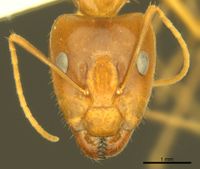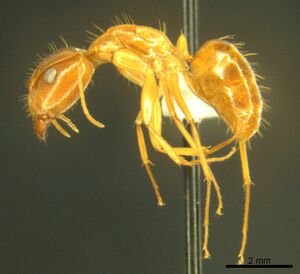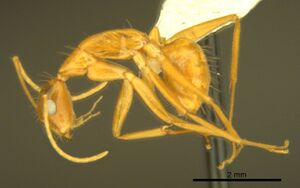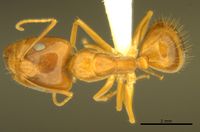Camponotus micronesicus
| Camponotus micronesicus | |
|---|---|

| |
| Scientific classification | |
| Kingdom: | Animalia |
| Phylum: | Arthropoda |
| Class: | Insecta |
| Order: | Hymenoptera |
| Family: | Formicidae |
| Subfamily: | Formicinae |
| Tribe: | Camponotini |
| Genus: | Camponotus |
| Species: | C. micronesicus |
| Binomial name | |
| Camponotus micronesicus Blanchard & Clouse, 2016 | |
This species is found in disturbed forest, both natural (e.g., reef islets, which are washed over during heavy storms) and anthropogenic (e.g., agroforest at low and middle elevations).
Identification
Clouse et al. (2016) - In Micronesia there are four closely related Camponotus species that resemble Camponotus maculatus (characters for which are described and illustrated in McArthur & Leys 2006): C. micronesicus, Camponotus eperiamorum, Camponotus kubaryi, and Camponotus tol. Of these species, only C. micronesicus is mostly concolorous yellow-orange, and with the other three species being island endemics, C. micronesicus can be collected alongside only one of them at a time (Clouse 2007a). In Melanesia collections of C. micronesicus are near those of three other described C. maculatus-like species: Camponotus chloroticus, Camponotus novaehollandiae, and Camponotus humilior. However, only the latter two share the lack of propleuron and hind femur standing hairs with C. micronesicus, and although uniformly yellow-orange specimens of C. humilior and C. novaehollandiae are occasionally seen, both species tend to be strongly bicolorous. Moreover, the head length and width measurements for both majors and minors of C. novaehollandiae are approximately 25% larger than those of C. micronesicus, and we have no evidence that the ranges of these species overlap exactly with C. micronesicus (C. humilior and C. novaehollandiae enter New Guinea only along the southern coast, where we have no C. micronesicus collections).
The most difficult cases of identification will be between Camponotus micronesicus and C. chloroticus specimens collected from Vanuatu, where they are sympatric and look nearly identical. Our best advice for identification is to check for hairs on the propleuron and hind femur, which should be absent in C. micronesicus and present in C. chloroticus. In addition, C. chloroticus minors usually have a larger cephalic index (74 - 82 vs. 67 - 74) and smaller scape index (123 - 154 vs. 175 - 191), both resulting from having a wider head; majors show the same trend, although those of C. chloroticus are highly variable.
Distribution
Distribution based on Regional Taxon Lists
Indo-Australian Region: Guam, Marshall Islands, Micronesia (Federated States of) (type locality), Northern Mariana Islands.
Distribution based on AntMaps
Distribution based on AntWeb specimens
Check data from AntWeb
Countries Occupied
| Number of countries occupied by this species based on AntWiki Regional Taxon Lists. In general, fewer countries occupied indicates a narrower range, while more countries indicates a more widespread species. |

|
Estimated Abundance
| Relative abundance based on number of AntMaps records per species (this species within the purple bar). Fewer records (to the left) indicates a less abundant/encountered species while more records (to the right) indicates more abundant/encountered species. |

|
Biology
The phylogeography of a group of Pacific Island Camponotus species, which included a number of species groups, was broadly examined by Clouse et al. (2015). They found Camponotus micronesicus is a member of a clade (Clade V) that originated in the Australian wet tropics and has become much more widespread and specieous.
Castes
Worker
Images from AntWeb

| |
| Holotype of Camponotus micronesicus. Worker (major/soldier). Specimen code antweb1008903. Photographer Ronald M. Clouse, uploaded by California Academy of Sciences. | Owned by MCZ, Cambridge, MA, USA. |
  
| |
| Paratype of Camponotus micronesicus. Worker. Specimen code antweb1008904. Photographer Ronald M. Clouse, uploaded by California Academy of Sciences. | Owned by MCZ, Cambridge, MA, USA. |
Nomenclature
The following information is derived from Barry Bolton's Online Catalogue of the Ants of the World.
- micronesicus. Camponotus micronesicus Blanchard & Clouse, in Clouse, et al. 2016: 147, figs. 13, 21-29 (s.w.) MICRONESIA (Pohnpei, Yap, Tol), PALAU, PAPUA NEW GUINEA, VANUATU.
- Type-material: holotype major worker, 8 paratype major workers, 7 paratype minor workers.
- Type-locality: holotype Micronesia: Pohnpei I., Nah Islet, 1 m., 15.ix.2010 (R. Clouse & P. Sharma); paratypes: 1 major worker, 1 minor worker with same data as holotype, 1 major worker, 1 minor worker Micronesia: Yap I., Mt Madeqdeq, 23.ix.2010 (R. Clouse & P. Sharma), 3 major workers, 2 minor workers Micronesia: Chuuk, Tol I., 120 m., 8.ix.2010 (R. Clouse, P. Sharma & Techuo family), 1 major worker, 1 minor worker Palau: Ngarchelong State, Ngarchor I., 3.v.2008 (J. Czekanski-Moir), 1 major worker, 1 minor worker Papua New Guinea: Lepa I., 6.xi.2010 (M. Janda), 1 major worker, 1 minor worker Vanuatu: Efate I., 3 km. W Epao Village, 200 m., 2.xi.2007 (C. Rabeling & E.O. Wilson).
- Type-depository: MCZC.
- Distribution: Micronesia, Palau, Papua New Guinea, Vanuatu.
Unless otherwise noted the text for the remainder of this section is reported from the publication that includes the original description.
Description
Worker
Holotype major: EL 0.55, EW 0.40, FCL 1.30, HL 2.50, HW 2.25, ML 3.00, MTL 1.80, PH 0.85, PL 0.65, SL 1.95; CI 90, SI 87.
Masticatory margin with six teeth that diminish in size unevenly from the apical tooth; teeth 2 - 5 similar in size, sixth tooth (not visible when mandibles closed) distinctly smaller. Clypeus continuing anteriorly past mandibular insertions one fourth its total height, then slightly convex. Posterior margin of clypeus straight to slightly concave, antennal insertions separated from clypeus by a distance almost equal to the distance from nearest clypeal margin to clypeal midpoint. Posterior head margin weakly concave to nearly flat. In frontal view: eyes located halfway between posterior clypeal margin and vertex; inner eye margins halfway between frontal lobes and sides of head; eyes not extending past lateral margin of head. Antennae 12-segmented. Antennal scape reaching past the posterior margin of head by a distance 1 - 2 times the width of the scape at its apex. Mesosoma in profile gently sloping from anterior pronotum to dorsal propodeum, with slightly steeper propodeal declivity. Petiolar node sloping evenly up to and down from its apex.
Color: Gaster and mesosoma uniformly yellow-orange, the head ranging from slightly to considerably darker orange-brown. Vertex to posterior frons and anterior frontal lobes orange brown, anterior frons and clypeus yellow-orange; central posterior head and frontal carina dark orange brown. Mandibles dark reddish brown, lighter at insertions, mandibular teeth black. Each gastral tergite with hyaline margin along posterior fifth.
Pilosity: Layer of small, recumbent, light hairs all over head. Longer, standing hairs numerous on front, back, and sides of head, longer at vertex and more dense on clypeus. From frontal view, area between eyes and frontal carina, two rows of long, standing hairs extending from vertex to mid-clypeus. Dorsal pronotum, mesonotum and vertex of propodeal angle with long standing hairs. Propleuron standing hairs lacking. Each gastral tergite with 10 to 20 long standing hairs encircling tergite immediately before hyaline margin along posterior edge; 5 to 10 longer standing hairs encircling tergite halfway between hyaline margin and posterior edge of previous tergite. Hind femur standing hairs lacking.
Sculpturing: Head, mesosoma, and gaster surface glossy; genae, clypeus, and mandibles weakly punctured.
Paratypes: Majors resembling holotype in coloration and pilosity, mesosoma ranging from light yellow to orange-yellow, heads sometimes distinctly darker than mesosoma but not brown. Generally same size or smaller than holotype (ML 2.65 - 3.00, HW 1.85 - 2.30), with similar head shapes (CI 86 - 92). Relative scape lengths more variable (SI 83 - 98). Minors approximately 15% - 20% smaller than majors (ML 2.2 - 2.5) but with much narrower heads (CI 67 - 74) and proportionally longer, more variable scapes (SI 175 - 191). Mesosoma coloration more consistently light yellow with similar or only slightly darker heads. Occipital carina always present. Measurements of minor worker collected with holotype: EL 0.40, EW 0.30, FCL 0.95, HL 1.35, HW 1.00, ML 2.30, MTL 1.50, PH 0.51, PL 0.50, SL 1.85; CI 74, SI 185.
Type Material
Holotype major worker, Federated States of Micronesia: Pohnpei Island, Nah Islet, 1 m a.s.l. (6º 51' 11.2" N, 158º 21' 16.3" E), 15.IX.2010, leg. R. Clouse and P. Sharma. Paratypes (8 major workers, 8 minor workers), detailed collection information provided in Table 4. All specimens are deposited in the Museum of Comparative Zoology, Harvard University, Massachusetts, USA.
Etymology
This species is named for Micronesia, the predominant region where it is found.
References
- Clouse, R. M., M. Janda, B. Blanchard, P. Sharma, B. D. Hoffmann, A. N. Andersen, J. E. Czekanski-Moir, P. Krushelnycky, C. Rabeling, E. O. Wilson, E. P. Economo, E. M. Sarnat, D. M. General, G. D. Alpert, and W. C. Wheeler. 2015. Molecular phylogeny of Indo-Pacific carpenter ants (Hymenoptera: Formicidae, Camponotus) reveals waves of dispersal and colonization from diverse source areas. Cladistics. 31:424-437. doi:10.1111/cla.12099
- Clouse, R.M., Blanchard, B.D., Gibson, R., Wheeler, W.C. & Janda, M. 2016. Taxonomic updates for some confusing Micronesian species of Camponotus (Hymenoptera: Formicidae: Formicinae). Myrmecological News 23: 139-152.


